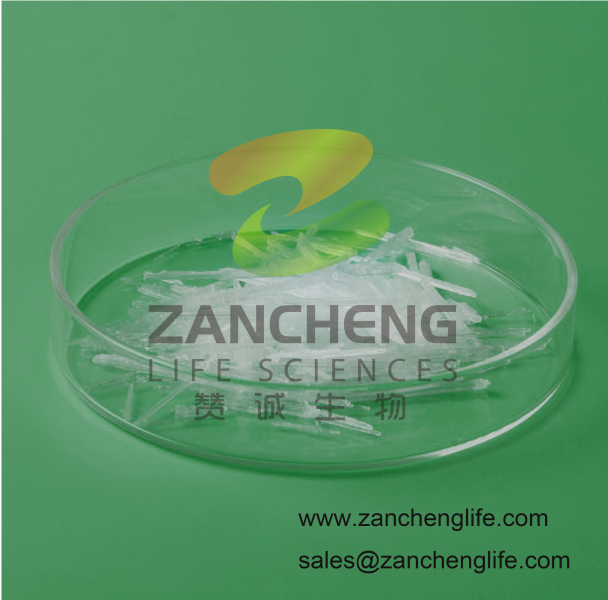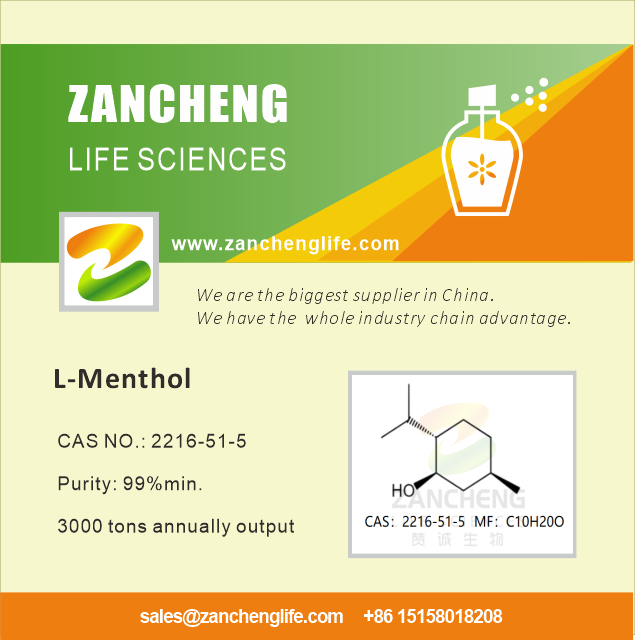Sep. 17, 2021
Menthol, also known as menthol, is a terpene organic compound with the chemical formula C10H20O. Menthol is extracted from the leaves and stems of peppermint, and is a white crystal that is the main component of peppermint and peppermint essential oil.
Menthol generally has two isomers (D-type and L-type), the natural menthol is mainly the levorotatory isomer (L-menthol), and menthol generally refers to the racemic menthol (DL-menthol).
There are three asymmetric carbon atoms in the molecular structure of menthol, so it has four stereoisomers.
In addition, since there are also three optical isomers, dextro, levo and achromatic, there will be a total of 12 isomers.
The different isomers differ in their aroma intensity and type as well as in their refreshing sensation.
The synthetic (±)-menthol is slightly less aromatic than the natural (-)-menthol, while the racemic neo-isomenthol, neo-menthol, and iso-menthol are less aromatic and have a camphoraceous scent, and the other isomers are less aromatic.

FEMA No.: 2665
Classification: Synthetic fragrance
Source: Peppermint brain is naturally present in pepper-like peppermint oil, Japanese peppermint oil, and to a lesser extent in essential oils such as vanilla oil.
Properties: white crystals.
Sensory characteristics: peppermint brain has a cool mint aroma.
Physical properties: Appearance is crystalline, boiling point 216.5℃, refractive index (20℃): 1.460~1.462 (when supercooled).
Using m-cresol as the starting material, alkylating with propylene to produce thymol, and then hydrogenating to make menthol, is the most widely used method in large-scale production. Catalytic hydrogenation of thymol is the industrial production method for the synthesis of (±)-menthol. The hydrogenated mixture contains about 60% of (±)-thymenthol, about 30% of (±)-neomenthol and about 10% of (±)-isomenthol. After efficient vacuum distillation, the (±)-menthocarpus is isolated to obtain the desired purity.
Menthol is widely used in edible flavors in large quantities. In particular, it is used in confectionery and beverage flavors. In addition, it is widely used in toothpaste and some cosmetic flavors, as well as in the pharmaceutical industry, where there are no IFRA restrictions.
L-menthol has a wide range of industrial uses, including the production of refreshing beverages and confectionery (mints, chewing gum, etc.), the cigarette industry, medical preparations, fragrance cosmetics and daily products. The main use of menthol in China is in the food and beverage industry and is rarely used in the cigarette industry.

In recent years, the global annual consumption of menthol is up to 40,000 tons, and the global annual production of crude menthol oil is close to or exceeds 100,000 tons. Currently, 70% of the L-menthol products in the international market are natural products, i.e. separated from crude menthol oil, and only 30% are chemically synthesized menthol products.
The current international market for menthol and peppermint oil is 34% in India, 32% in Brazil, both of which are evenly matched, 21% in China, and only 13% in other countries and regions.
China's domestic production and demand situation of L-menthol is still in a state of self-sufficiency, and every year are imported from overseas about 12,000 tons of chemically synthesized L-menthol products.
It is reported that 70% of the international menthol market is natural products and the remaining 30% is synthetic products. At present, the international synthetic menthol market is mainly monopolized by three giants, namely Japan Takasago Spice Company, Germany BASF Corporation and Germany Dezin Company. The latter two synthetic menthol production accounted for about 86% of the total international synthetic menthol sales, Japan synthetic menthol accounted for only 14%.
Our company supplies L-menthol, the factory production has the advantage of a complete industrial chain, starting from the starting raw material m-cresol, the main raw materials are all the strong products of the factory.The annual production capacity of the factory is 4000 tons of thymol and 3000 tons of l-menthol. Contact us if you need.
Navigation
Phone:
+86 151 5801 8208
+86 138 0570 9842
E-mail:
Add.:
ROOM 702, NO.318, HUAYUANGANG STREET, GONGSHU DISTRICT, HANGZHOU, ZHEJIANG, CHINA
Request a Quote